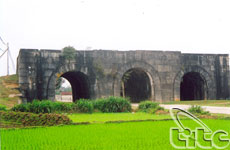Hundreds of ancient stone cannon-balls have been discovered at the world-recognised heritage site Citadel of Ho Dynasty in the central province of Thanh Hoa.
 The Centre for Conservation of Ho Dynasty Citadel World Heritage said its staff found the cannon bullets during an excavation jointly conducted with archaeologists at Hoang Gia Road or Hoe Nhai Road which links the southern gate of the citadel with the Nam Giao esplanade on Don Son Mountain.
The Centre for Conservation of Ho Dynasty Citadel World Heritage said its staff found the cannon bullets during an excavation jointly conducted with archaeologists at Hoang Gia Road or Hoe Nhai Road which links the southern gate of the citadel with the Nam Giao esplanade on Don Son Mountain.
The round-shaped cannon-balls were polished carefully with the largest measuring 10-15 centimetres in diameter and the smallest having a diameter of 5-7 centimetres.
The Ho Dynasty Citadel was Vietnam's capital under the Ho Dynasty (1398-1407).
Located in Vinh Tien and Vinh Long communes in Vinh Loc district, the citadel measures 870m by 883m and was built within only three months, between January and March of 1937. It is the only one built entirely of stone in Vietnam and remained almost intact through ups and downs in history.
Also known as the Tay Do, An Ton, Tay Kinh or Tay Giai citadel, the ancient building is famous for being strategically located where it could be easily defended. The citadel is protected by a mountain range to the north, while the Ma River runs to its west and the Buoi River to its south, creating a huge natural moat.
The Citadel, built according to the feng shui principles, was sited in a landscape of great scenic beauty on an axis joining the Tuong Son and Don Son Mountains. The citadel buildings represent an outstanding example of a new style of south-east Asian imperial city.
It was recognised as a World Heritage Site by the UN Educational, Scientific and Cultural Organisation (UNESCO) in June 2011.